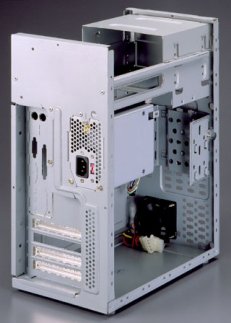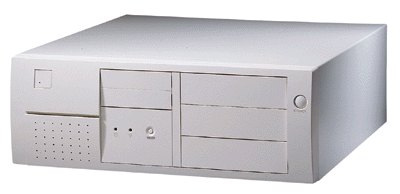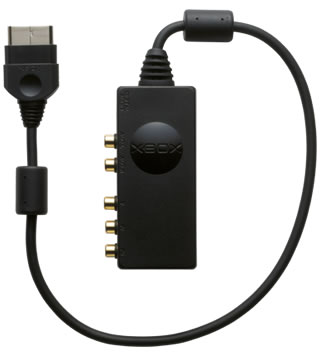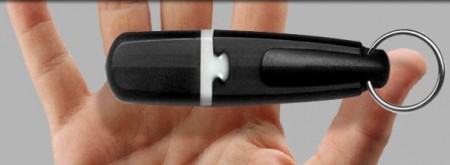I’m a big fan of Antec cases, having two [intlink id=”629″ type=”post”]SX1000[/intlink] series in use. I’ve been eyeing the new Performance Plus and Performance II series but found the price to be a little steep for my tastes. Recently I was perusing their site and found the Solution series, a low cost alternative. A quick Google search revealed no reviews, so I ordered the largest of the series, the SLK3700AMB. After a few weeks went by it arrived. Within minutes of opening the box I was thoroughly impressed.
I’ll do my usual case review of moving from the outside in. Let’s look at the model number first: SLK3700AMB. Antec likes long model numbers, and this is no exception. AMB stands for Antec Metallic Bronze, referring to their new metallic colour schemes. Opening the box revealed this stunning colour. The paint job is very sharp, even and a glossy automotive finish. I’m used to a mat finish and haven’t been impressed by aluminum cases that are all the rage these days. The front bezel is plastic, the top and sides are painted steel. That’s right, heavy non pliable steel. Hefting this unit makes you realize you’re not getting that fancy new aluminum the kids are talking about.
Following in the steps of the SX and Plus series, there is a front swinging door that covers the drive bays and buttons. This is the first area we see cost cutting, with no lock on the front or side panel. Not really needed anyway.
Swinging open the front door shows the power and reset buttons, plus four lights. One power, one hard drive and two generic for whatever you’d like. The hard drive and two generic lights are labeled “HDD LED” on their two pin connectors, so there’s a bit of playing around during set up to determine which is which. Below the front door are two USB connections. Very handy indeed.
Moving to the rear, we see the usual complement of ATX cutouts, colour coded and labeled via universal symbols. The second change for Antec shows in the rear fan: a single 120mm fan as opposed to dual 80mm fans. This is an Antec 120mm Fan, nothing special, that spins at 1200 rpm. I found it a little loud for that speed, but it moved a good deal of air. One rear fan comes standard with the case.
The side panel is removed by pressing the two levers, opening them to 90 degrees and pulling the panel towards the front. Once inside we see a lot of difference from other Antec cases. Instead of two removable 3.5″ drive cages with handles, a single two drive cage sits in the middle. Below that is a five drive removable cage. Two things about this are unique: it’s secured via a thumb screw and handle, and is removed by pulling it directly out of the case. This is a great feature, as the other Antec cages have to be pulled towards the back of the case, along the motherboard before coming free. The second great feature is the rubber washers that secure the drives into the case. To accommodate this special screws are provided, which is a two edged sword for those who tend to misplace small items. No more worries of vibrating drives and metallic rattling. Unfortunately the rubber washers are only used on the five drive cage, not on the 5.25″ drive rails or two drive 3.5″ cage.
The interior is clean and well designed, with labeled motherboard mount holes. differentiating ATX, AT and Extended ATX. Another great new feature is a permanent mounting post in a hole used by all three motherboard types, on the right middle. This allows you to put a motherboard into the case and keep it in place via this mount, so you can screw the board down comfortably without trying to juggle it with one hand while you hold a screw and screwdriver with the other.
Mounting 5.35″ drives now requires the front bezel to be removed. It comes off by pressing on two clips on the bottom, then pinching two clips in the internal middle. It was a bit tricky the first few times, but got easier after. Drives need rails which come with the case, and slip into the slots. This time the drive rails are all metal, and come loose in a box. Once the drives are mounted the front bezel snaps back on and leaves a clean look to the front. My other Antec cased didn’t require the bezel to be removed, but the front didn’t look as clean because of the exposed clips on the drive rails.
Inside the front bezel is a removable filter covering the front air intake. This is a great way to keep that dust out of the case. In behind the front air intake is a mount for another 120 mm case fan, not included. Antec’s fan mounts have clips at the top and bottom, so the fan’s don’t need screws.
Included with the case is a 350 watt Antec power supply. Great build quality, but not one of the new TruPower models that use the noise “Silencer” technology. Not to say it’s loud, as a “standard” power supply from Antec is a step above.ATA RAID testbed. This case has been improved by the additional of a small PC speaker mounted behind the removable hard drive cage. Now if only they would change the front USB connectors…
Not to say I loved everything about the case. The front mounted USB cables have all ten pins with individual plastic covers, so you have to read your motherboard manual and try to match them up. While this allows for maximum compatibility, it took me a few tries to get them working. Another problem is the lack of a case speaker. Case manufacturers are moving away from them, but most include at least a small circular speaker attached to the four pin motherboard connector. My final gripe is the fact that full size PCI cards won’t fit. While this seems minor, to use all five hard drive bays you’ll be using an ATA RAID or SCSI controller which may require the additional real estate.
Let me sum it up: I love this case and will be buying them from now on. Nuff said.
Update / Revision April 11th 2003
I just picked up another Antec SLK3700AMB case for my ATA RAID testbed. This case has been improved by the additional of a small PC speaker mounted behind the removable hard drive cage. Now if only they would change the front USB connectors…
Editors note: this review was migrated from the old eBabble.net site and the photos updated. Originally published January 30th 2003.




